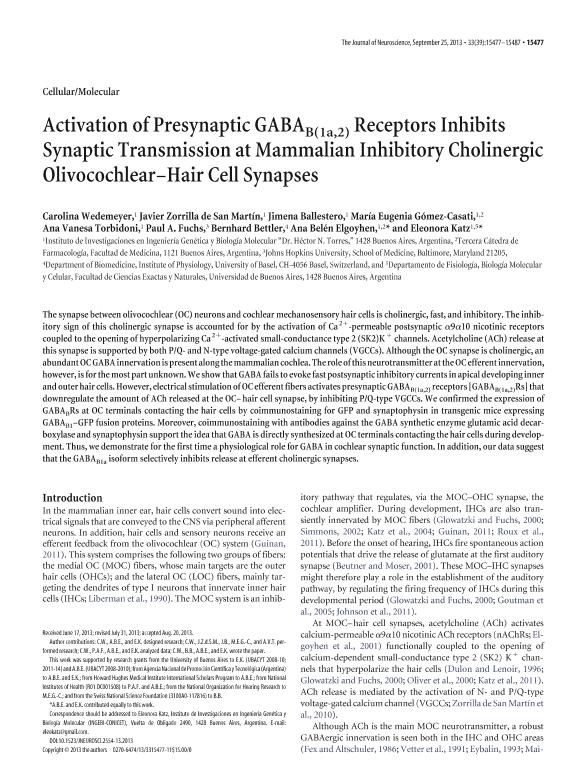Mostrar el registro sencillo del ítem
dc.contributor.author
Wedemeyer, Carolina

dc.contributor.author
Zorrilla de San Martín, Javier

dc.contributor.author
Ballestero, Jimena Andrea

dc.contributor.author
Gomez Casati, Maria Eugenia

dc.contributor.author
Torbidoni, Ana Vanesa

dc.contributor.author
Fuchs, Paul A.
dc.contributor.author
Bettler, Bernhard

dc.contributor.author
Elgoyhen, Ana Belen

dc.contributor.author
Katz, Eleonora

dc.date.available
2019-07-16T14:17:02Z
dc.date.issued
2013-09
dc.identifier.citation
Wedemeyer, Carolina; Zorrilla de San Martín, Javier; Ballestero, Jimena Andrea; Gomez Casati, Maria Eugenia; Torbidoni, Ana Vanesa; et al.; Activation of presynaptic GABA b(1a,2) receptors inhibits synaptic transmission at mammalian inhibitory cholinergic olivocochlear-hair cell synapses; Society for Neuroscience; Journal of Neuroscience; 33; 39; 9-2013; 15477-15487
dc.identifier.issn
0270-6474
dc.identifier.uri
http://hdl.handle.net/11336/79619
dc.description.abstract
The synapse between olivocochlear (OC) neurons and cochlear mechanosensory hair cells is cholinergic, fast, and inhibitory. The inhibitory sign of this cholinergic synapse is accounted for by the activation of Ca 2+ -permeable postsynaptic α9α10 nicotinic receptors coupled to the opening of hyperpolarizing Ca 2+ -activated small-conductance type 2 (SK2)K + channels. Acetylcholine (ACh) release at this synapse is supported by both P/Q- and N-type voltage-gated calcium channels (VGCCs). Although the OC synapse is cholinergic, an abundantOCGABAinnervation is present along themammaliancochlea. The role of this neurotransmitter at theOCefferent innervation, however, is for the most part unknown.Weshow thatGABAfails to evoke fast postsynaptic inhibitory currents in apical developing inner and outer hair cells. However, electrical stimulation ofOCefferent fibers activates presynapticGABA B(1a,2) receptors [GABAB (1a,2) Rs] that downregulate the amount of ACh released at the OC-hair cell synapse, by inhibiting P/Q-type VGCCs. We confirmed the expression of GABA B Rs at OC terminals contacting the hair cells by coimmunostaining for GFP and synaptophysin in transgenic mice expressing GABA B1 -GFP fusion proteins. Moreover, coimmunostaining with antibodies against the GABA synthetic enzyme glutamic acid decarboxylase and synaptophysin support the idea that GABA is directly synthesized at OC terminals contacting the hair cells during development. Thus, we demonstrate for the first time a physiological role for GABA in cochlear synaptic function. In addition, our data suggest that the GABA B1a isoform selectively inhibits release at efferent cholinergic synapses.
dc.format
application/pdf
dc.language.iso
eng
dc.publisher
Society for Neuroscience

dc.rights
info:eu-repo/semantics/openAccess
dc.rights.uri
https://creativecommons.org/licenses/by-nc-sa/2.5/ar/
dc.subject
Hair Cells
dc.subject
Cholinergic
dc.subject
Gabab Receptors
dc.subject
Synaptic Transmission
dc.subject
Efferent Innervation
dc.subject.classification
Neurociencias

dc.subject.classification
Medicina Básica

dc.subject.classification
CIENCIAS MÉDICAS Y DE LA SALUD

dc.title
Activation of presynaptic GABA b(1a,2) receptors inhibits synaptic transmission at mammalian inhibitory cholinergic olivocochlear-hair cell synapses
dc.type
info:eu-repo/semantics/article
dc.type
info:ar-repo/semantics/artículo
dc.type
info:eu-repo/semantics/publishedVersion
dc.date.updated
2019-07-11T19:18:49Z
dc.journal.volume
33
dc.journal.number
39
dc.journal.pagination
15477-15487
dc.journal.pais
Estados Unidos

dc.journal.ciudad
Washington
dc.description.fil
Fil: Wedemeyer, Carolina. Consejo Nacional de Investigaciones Científicas y Técnicas. Instituto de Investigaciones en Ingeniería Genética y Biología Molecular "Dr. Héctor N. Torres"; Argentina
dc.description.fil
Fil: Zorrilla de San Martín, Javier. Consejo Nacional de Investigaciones Científicas y Técnicas. Instituto de Investigaciones en Ingeniería Genética y Biología Molecular "Dr. Héctor N. Torres"; Argentina
dc.description.fil
Fil: Ballestero, Jimena Andrea. Consejo Nacional de Investigaciones Científicas y Técnicas. Instituto de Investigaciones en Ingeniería Genética y Biología Molecular "Dr. Héctor N. Torres"; Argentina
dc.description.fil
Fil: Gomez Casati, Maria Eugenia. Consejo Nacional de Investigaciones Científicas y Técnicas. Instituto de Investigaciones en Ingeniería Genética y Biología Molecular "Dr. Héctor N. Torres"; Argentina. Universidad de Buenos Aires. Facultad de Medicina; Argentina
dc.description.fil
Fil: Torbidoni, Ana Vanesa. Consejo Nacional de Investigaciones Científicas y Técnicas. Instituto de Investigaciones en Ingeniería Genética y Biología Molecular "Dr. Héctor N. Torres"; Argentina
dc.description.fil
Fil: Fuchs, Paul A.. Johns Hopkins University; Estados Unidos
dc.description.fil
Fil: Bettler, Bernhard. Universidad de Basilea; Suiza
dc.description.fil
Fil: Elgoyhen, Ana Belen. Consejo Nacional de Investigaciones Científicas y Técnicas. Instituto de Investigaciones en Ingeniería Genética y Biología Molecular "Dr. Héctor N. Torres"; Argentina. Universidad de Buenos Aires. Facultad de Medicina; Argentina
dc.description.fil
Fil: Katz, Eleonora. Consejo Nacional de Investigaciones Científicas y Técnicas. Instituto de Investigaciones en Ingeniería Genética y Biología Molecular "Dr. Héctor N. Torres"; Argentina. Universidad de Buenos Aires. Facultad de Ciencias Exactas y Naturales. Departamento de Fisiología, Biología Molecular y Celular; Argentina
dc.journal.title
Journal of Neuroscience

dc.relation.alternativeid
info:eu-repo/semantics/altIdentifier/url/https://www.ncbi.nlm.nih.gov/pmc/articles/pmid/24068816/
dc.relation.alternativeid
info:eu-repo/semantics/altIdentifier/doi/http://dx.doi.org/10.1523/JNEUROSCI.2554-13.2013
dc.relation.alternativeid
info:eu-repo/semantics/altIdentifier/url/https://www.jneurosci.org/content/33/39/15477
Archivos asociados
